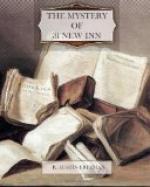“Yes,” said Marchmont; “I think we must admit the identification as being quite conclusive, though the evidence is of a kind that is more striking to the medical than to the legal mind.”
“You will not have that complaint to make against the next item of evidence,” said Thorndyke. “It is after the lawyer’s own heart, as you shall hear. A few days ago I wrote to Mr. Stephen asking him if he possessed a recent photograph of his uncle Jeffrey. He had one, and he sent it to me by return. This portrait I showed to Dr. Jervis and asked him if he had ever seen the person it represented. After examining it attentively, without any hint whatever from me, he identified it as the portrait of the sick man, Graves.”
“Indeed!” exclaimed Marchmont. “This is most important. Are you prepared to swear to the identity, Dr. Jervis?”
“I have not the slightest doubt,” I replied, “that the portrait is that of Mr. Graves.”
“Excellent!” said Marchmont, rubbing his hands gleefully; “this will be much more convincing to a jury. Pray go on, Dr. Thorndyke.”
“That,” said Thorndyke, “completes the first part of my investigation. We had now reached a definite, demonstrable fact; and that fact, as you see, disposed at once of the main question—the genuineness of the will. For if the man at Kennington Lane was Jeffrey Blackmore, then the man at New Inn was not. But it was the latter who had signed the will. Therefore the will was not signed by Jeffrey Blackmore; that is to say, it was a forgery. The case was complete for the purposes of the civil proceedings; the rest of my investigations had reference to the criminal prosecution that was inevitable. Shall I proceed, or is your interest confined to the will?”
“Hang the will!” exclaimed Stephen. “I want to hear how you propose to lay hands on the villain who murdered poor old uncle Jeffrey—for I suppose he did murder him?”
“I think there is no doubt of it,” replied Thorndyke.
“Then,” said Marchmont, “we will hear the rest of the argument, if you please.”
“Very well,” said Thorndyke. “As the evidence stands, we have proved that Jeffrey Blackmore was a prisoner in the house in Kennington Lane and that some one was personating him at New Inn. That some one, we have seen, was, in all probability, John Blackmore. We now have to consider the man Weiss. Who was he? and can we connect him in any way with New Inn?
“We may note in passing that Weiss and the coachman were apparently one and the same person. They were never seen together. When Weiss was present, the coachman was not available even for so urgent a service as the obtaining of an antidote to the poison. Weiss always appeared some time after Jervis’s arrival and disappeared some time before his departure, in each case sufficiently long to allow of a change of disguise. But we need not labour the point, as it is not of primary importance.




